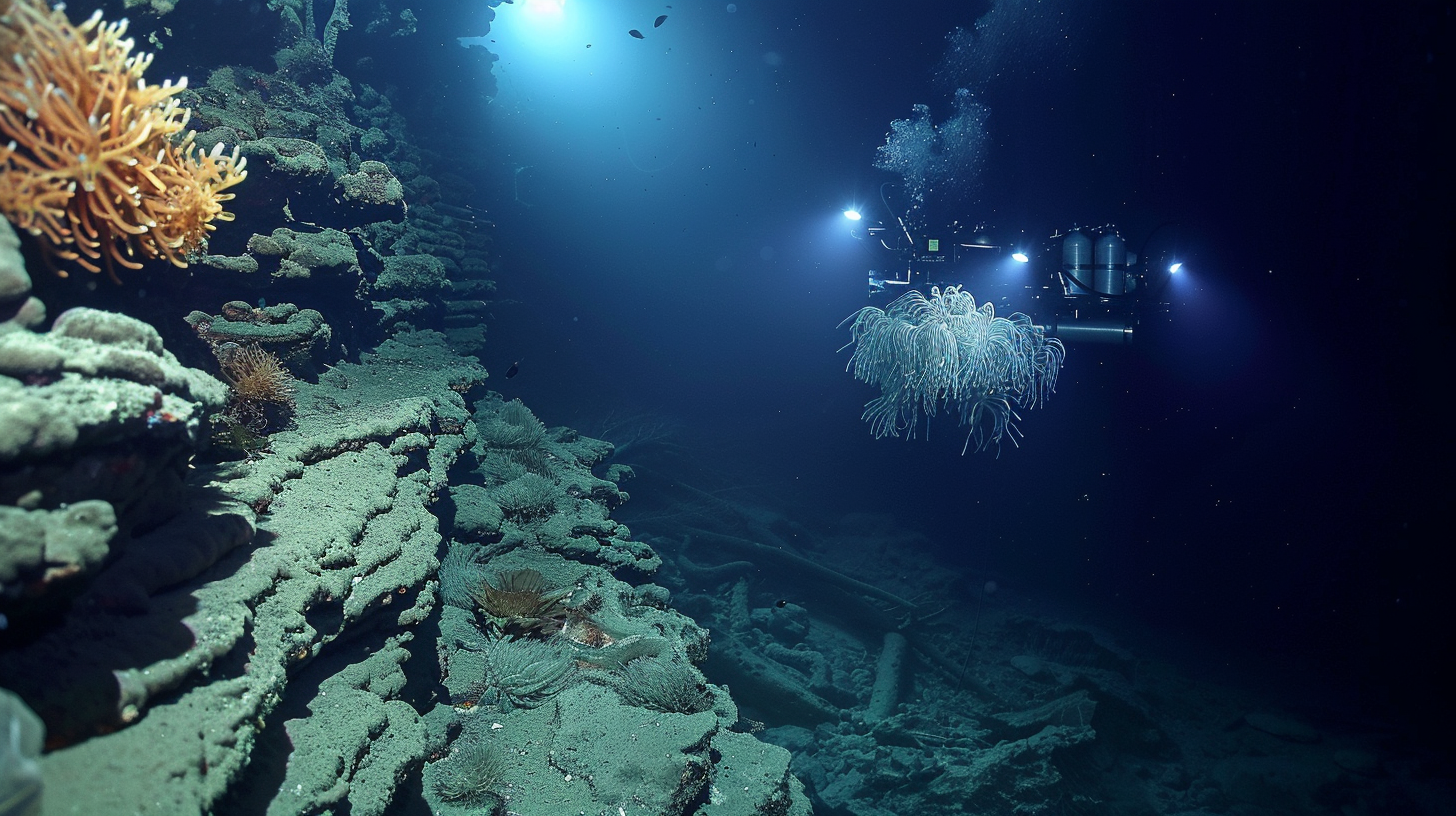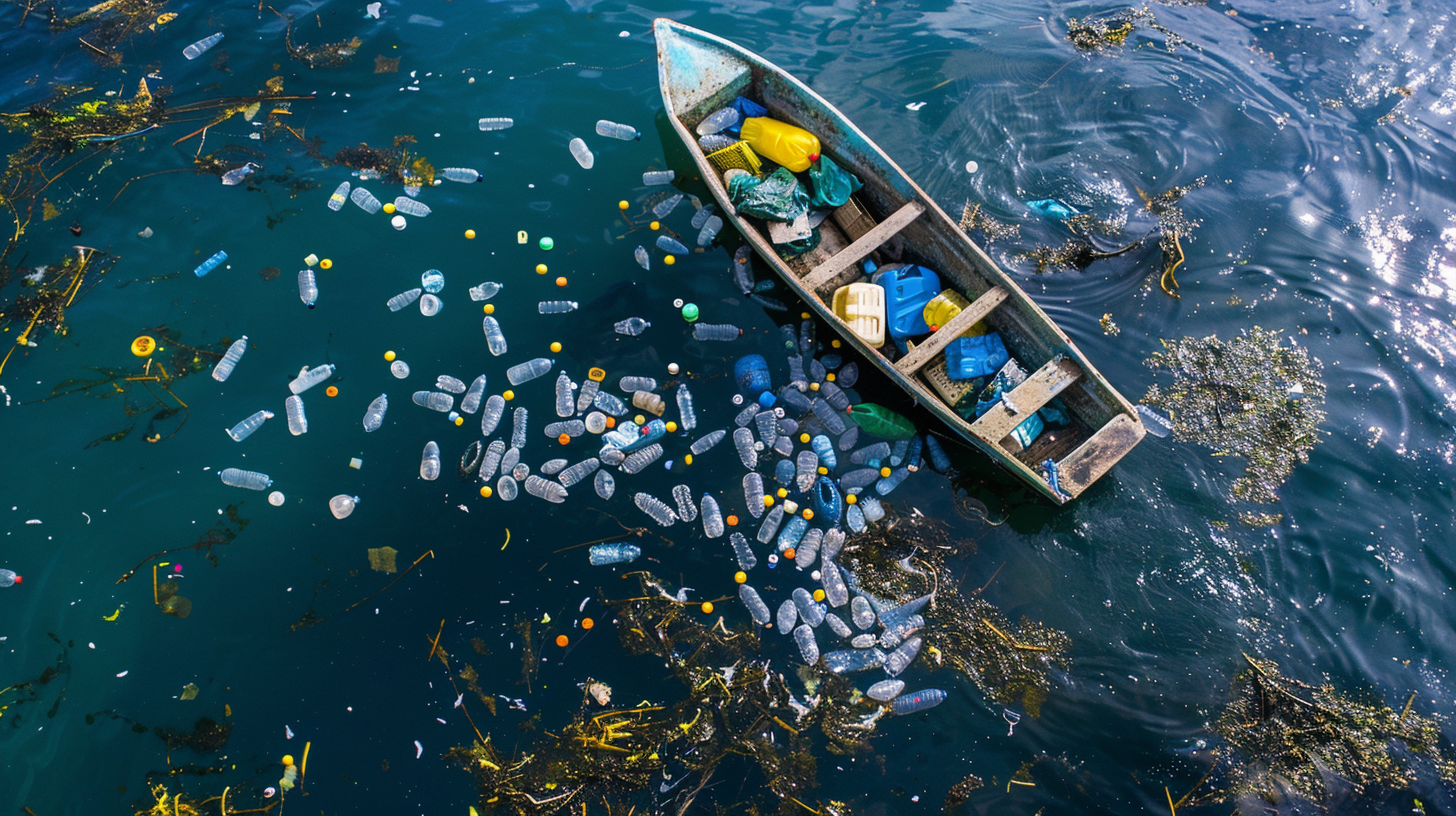Table of Contents Show
In our quest to understand the world’s largest, yet least understood, natural feature, we’ve gently lifted the veil on the ocean’s most secretive territories. Our journey into the abyss has revealed wonders from revolutionary underwater drones that navigate the uncharted domains to discovering species that redefine our understanding of life. Each discovery not only adds a piece to the vast puzzle of ocean science but also raises new questions about the mysteries lying in wait. We’re on the brink of uncovering secrets that could change how we see our planet. Why stop now when the next discovery could be just beneath the surface?
Key Takeaways
- Deep-sea explorations uncover life forms with unique adaptations in extreme environments.
- Technological advancements provide unprecedented access to the ocean’s abyssal depths.
- Discoveries shed light on biodiversity and ecosystems operating in total darkness.
- Ocean conservation efforts are crucial in addressing environmental challenges and sustaining new findings.
Unveiling Deep-Sea Mysteries
We’ve discovered astonishing secrets in the deep sea, revealing a world far more complex and mysterious than we ever imagined. Every expedition brings us closer to understanding the uncharted territories beneath the waves, where life thrives against all odds. It’s as if we’re opening a treasure chest of knowledge, one discovery at a time, and what we’re finding is reshaping our understanding of life on Earth.
In these depths, we’ve encountered species that defy our understanding of biology, creatures that can withstand extreme pressure, and environments that are both harsh and beautiful. We’re seeing ecosystems that operate entirely without sunlight, relying instead on chemosynthesis, a process that’s as fascinating as it is alien to our sunlit world above. These discoveries are not just important; they’re a proof to the resilience and adaptability of life. They challenge us to think differently about our own existence and how we relate to this planet.
We’re also discovering clues about Earth’s past, hidden within the depths. The deep sea holds records of ancient climates and extinct species, offering us a glimpse into millennia gone by. These findings are critical for understanding how our planet has changed over time and how it might continue to evolve.
Embracing the spirit of exploration, we’re pushing the boundaries of what’s known, driven by a desire for freedom from the confines of our current understanding. There’s a whole world beneath the waves, waiting to be understood, and we’re just at the beginning of this grand adventure. As we explore deeper, we’re not just investigating the ocean; we’re rediscovering our planet and, in the process, ourselves.
Revolutionary Underwater Drones
Exploring the ocean’s depths, revolutionary underwater drones are expanding our capability to uncover its most hidden secrets. We’re witnessing a new era where technology meets the vast, unexplored waters, offering us the freedom to explore realms that were once beyond our reach. These drones, equipped with cutting-edge technology, are voyaging the deep blue like never before, bringing back invaluable data that’s reshaping our understanding of the ocean.
Let’s plunge into how these drones are changing the game:
-
Unprecedented Access: These drones can plunge into abyssal depths, reaching areas that human divers can’t, all while transmitting live footage and data back to us. It’s like having our own remote-controlled submarines, giving us front-row seats to the mysteries of the deep.
-
Data Collection and Environmental Monitoring: They’re not just for show; these drones collect critical data on water temperatures, salinity levels, and even map the ocean floor’s topography. This information is vital for environmental monitoring, helping us understand the impacts of climate change on oceanic ecosystems.
-
Discovery and Rescue Missions: Beyond exploration, these drones play a vital role in search and rescue operations, locating shipwrecks and downed aircraft in the murky depths. They’re essential tools in missions that would be too dangerous or impossible for humans to undertake.
We’re on the brink of a new frontier, where our curiosity isn’t limited by physical boundaries. These underwater drones are not just tools; they’re our eyes in the deep, revealing the ocean’s secrets and bringing them into the light.
The Abyss: Biodiversity Uncharted
Beneath the waves lies an uncharted world of biodiversity, teeming with life that defies imagination. We’re just beginning to scratch the surface of what exists in the deep, dark corners of the ocean, where sunlight dares not reach. Here, in the abyss, creatures have adapted in ways that seem more akin to science fiction than the natural world we think we comprehend.
As we explore deeper, we’re constantly astounded by the variety and resilience of life. Species unknown to us thrive in conditions we once thought uninhabitable. They’ve evolved unique methods to survive, from bioluminescence to incredible adaptations for pressure and cold. It’s a domain where the rulebook of surface life doesn’t apply, and every discovery challenges our understanding of life’s limits.
Our journey into these depths isn’t just about curiosity. It’s a quest for freedom from the confines of our own ignorance. Each species we uncover holds potential insights into biology, medicine, and the very essence of survival. We’re not just investigating; we’re uncovering secrets that could revolutionize how we live.
Yet, we’re reminded that this vast, uncharted biodiversity is vulnerable. Our actions above the surface have repercussions that ripple down into these hidden habitats. Protecting this unexplored frontier becomes a mandate for us all. We’re on the cusp of understanding the intricate web of life that exists in the abyss, and it’s our responsibility to guarantee it thrives for generations to come. This journey isn’t just about discovery; it’s about safeguarding the mysteries and marvels that lie in the depths.
Hydrothermal Vents and Life
We’re now turning our attention to the fascinating world of hydrothermal vents and the life they support. We’ll explore the diverse ecosystems these vents host, understand how they form, and uncover the mechanisms species use to adapt to such extreme conditions. It’s a journey that reveals the resilience and complexity of life in the deep sea.
Vent Ecosystem Diversity
Hydrothermal vents host a remarkable variety of life, challenging our understanding of where and how life can thrive in extreme conditions. These ecosystems are not just fascinating; they’re a demonstration of life’s resilience and adaptability. We’ve discovered that in these seemingly inhospitable environments, life flourishes, pushing the boundaries of what we thought was possible.
To truly appreciate the diversity and significance of these ecosystems, consider:
- Unique Species: Vent ecosystems are home to species found nowhere else on Earth, from giant tube worms to heat-tolerant microbes.
- Symbiotic Relationships: Many vent organisms rely on symbiotic relationships with bacteria, showcasing nature’s collaborative spirit.
- Biological Insights: Studying these organisms offers insights into the limits of life, potentially guiding the search for life beyond Earth.
It’s a domain of freedom for life, thriving against the odds.
Vent Formation Processes
Exploring the depths of the ocean, we uncover the intricate processes that lead to the formation of hydrothermal vents, serving as the cradle of life in the deep sea. These vents form when seawater seeps into the Earth’s crust, heats up by the magma, and then spews back out, loaded with minerals. This process not only creates spectacular underwater landscapes but also supports unique ecosystems. We’re fascinated by how these vents act as natural laboratories, offering us insights into life’s resilience and adaptability. They remind us of nature’s ability to thrive in the most extreme conditions, challenging our perceptions of life’s boundaries. By understanding these natural wonders, we’re not just expanding our knowledge; we’re celebrating the freedom to explore the uncharted, to question, and to discover.
Species Adaptation Mechanisms
Having uncovered the fascinating processes behind the formation of hydrothermal vents, let’s now examine how species in these environments adapt to their extreme conditions. Life here thrives in darkness, under immense pressure, and with temperatures that can soar above 400°C. Yet, these seemingly hostile conditions are home to a diverse array of life.
Here are three key adaptation mechanisms:
- Chemical Energy Utilization: Unlike surface-dwelling organisms that rely on sunlight, vent species harness chemical energy from the Earth’s minerals.
- Thermal Resistance: They’ve developed proteins that remain stable and functional at high temperatures.
- Pressure Adaptation: Their cellular structures are designed to withstand the crushing pressures of the deep sea, ensuring their survival in this otherworldly habitat.
We’re exploring freedom in the most unlikely places, uncovering life’s resilience and adaptability.
New Species From the Depths
We’ve recently uncovered a plethora of new species in the uncharted depths of our oceans, shedding light on the mysteries lurking below. These discoveries offer us a glimpse into a world that remains largely untouched by human influence, a true illustration of nature’s boundless creativity and resilience. As we explore deeper, we’re constantly reminded of the ocean’s vastness and the freedom it embodies, a domain where life thrives against all odds, in extreme conditions we’re only beginning to understand.
Among these new finds are species that challenge our understanding of biology and adaptation. Creatures with unique, bioluminescent features that illuminate the pitch-black environments they inhabit, and others with astonishing forms of resilience and survival strategies, are just the tip of the iceberg. Their existence opens up new avenues for research and exploration, offering us valuable lessons on sustainability and innovation.
Exploring these depths, we’re not just discovering new species; we’re uncovering the secrets of our planet’s last frontier. Each expedition brings us closer to understanding the intricate web of life that sustains the ocean’s ecosystem. It’s a reminder of the freedom that comes with exploration and the responsibility we carry to protect these untouched sanctuaries.
Our journey into the abyss is far from over. With each plunge, we peel back another layer of the ocean’s mysteries, revealing the incredible diversity and resilience of life on Earth. These discoveries not only enrich our knowledge but also fuel our imagination, reminding us of the endless possibilities that lie in the pursuit of freedom and exploration.
Oceanic Data Through AI
We’ve turned our focus to how AI-powered analysis techniques are revolutionizing our understanding of the oceans. By harnessing these advanced technologies, we’re starting to expose hidden marine secrets that were once beyond our reach. This breakthrough allows us to explore the vast, uncharted waters of our planet in ways we never thought possible.
AI-Powered Analysis Techniques
Revolutionizing ocean science, AI-powered analysis techniques are revealing the secrets of vast underwater ecosystems. By harnessing the power of artificial intelligence, we’re not just observing; we’re understanding the ocean like never before. These advancements offer us the freedom to explore and protect our planet’s most uncharted territories.
Here’s how AI is changing the game:
- Automating Data Analysis: We’re sifting through mountains of oceanic data at unprecedented speeds, uncovering patterns and anomalies that were once invisible to us.
- Predictive Modeling: AI helps us anticipate changes in marine environments, empowering us to act swiftly in conservation efforts.
- Enhanced Imaging Techniques: With AI, we’re translating raw, murky underwater images into clear, actionable insights, freeing us to explore deeper and with greater precision.
Unveiling Hidden Marine Secrets
Harnessing AI, we’re now peeling back the ocean’s mysterious veil, revealing secrets hidden deep beneath the waves. This journey into the unknown isn’t just about discovery; it’s about liberating the secrets that the ocean has tightly held for millennia. By integrating AI with oceanic exploration, we’re not only uncovering new marine species and ecosystems but also gaining insights into the health of our planet. This technology empowers us to monitor oceanic changes with unprecedented precision, ensuring we’re always a step ahead in conservation efforts. It’s a confirmation of human ingenuity, a bridge between the desire for freedom and the responsibility of stewardship. We’re charting a course for the future, where the depths of the ocean no longer represent the unknown, but a wellspring of knowledge and opportunity.
Climate Change: Oceanic Impact
As the planet continues to warm, our oceans are experiencing profound impacts, from rising temperatures to altered ecosystems. We’re witnessing not just subtle shifts but significant transformations that challenge the marine life we’ve long taken for granted. Let’s delve into the ways climate change is reshaping our oceans and what we can do to navigate these turbulent waters with a sense of freedom and responsibility.
-
Rising Sea Temperatures: The ocean absorbs much of the Earth’s excess heat, leading to warmer waters. This increase in temperature affects coral reefs, causing bleaching and jeopardizing the rich biodiversity they support. It’s not just about protecting these ecosystems; it’s about preserving our heritage and ensuring our future.
-
Acidification: As oceans absorb CO2, their chemistry changes, becoming more acidic. This poses a threat to calcifying organisms such as shellfish and corals, impacting food chains and human industries dependent on these species. We’re in a race against time to reduce emissions and safeguard our marine resources.
-
Changing Ocean Currents: The alteration of ocean currents due to climate change affects weather patterns, marine habitats, and fisheries. This can lead to more extreme weather events and disrupt the livelihoods of millions. We must adapt and innovate, finding ways to coexist with these new realities.
In facing these challenges, we’re not just fighting for the oceans; we’re fighting for our freedom to thrive in a changing world. By embracing sustainable practices and pushing for systemic change, we can steer our planet towards a healthier, more resilient future.
Secrets of Deep-Sea Corals
While we grapple with the ocean’s changing climate, the mysteries of deep-sea corals offer a glimmer of hope and a field ripe for discovery. These incredible organisms, thriving in conditions we once thought impossible, show us resilience and adaptation in the face of adversity. They’re not just surviving; they’re thriving, revealing secrets we’re just beginning to understand.
We’ve found that deep-sea corals form complex habitats, offering sanctuary to a myriad of marine life. Their existence in the ocean’s abyss, where sunlight dares not reach, challenges our understanding of life’s adaptability. It’s as if they’re whispering to us, encouraging us to look beyond our constraints, telling us there’s a way if we’re willing to explore and adapt.
Our recent explorations have unveiled that these corals are not merely survivors of the deep blue; they are historians of the ocean, recording centuries of marine environmental changes within their skeletal structures. By studying them, we’re revealing past oceanic conditions, gaining insights that could guide our fight against climate change. It’s a journey of discovery that beckons us, promising freedom from our current limitations and offering a new perspective on resilience and adaptation.
As we delve deeper into the secrets of deep-sea corals, we’re not just exploring the unknown; we’re finding hope. Hope that amidst the challenges posed by a changing climate, there are opportunities for discovery, for adaptation, and for a better understanding of the world that surrounds us. Let’s embrace this freedom to explore, to learn, and to grow.
Underwater Volcanoes Explored
Venturing into the depths of the ocean, we’ve turned our focus to the enigmatic world of underwater volcanoes, revealing a landscape as dynamic and alive as any on the surface. We’ve plunged into this mysterious domain, keen to uncover the secrets that lie beneath the waves, where magma meets water, creating a spectacle unlike any other. Our journey has brought us face-to-face with these giants, whose eruptions shape the very foundation of life in the ocean.
Here’s what we’ve discovered:
-
Diverse Ecosystems Thrive: We’ve found that these underwater mountains are teeming with life, hosting unique ecosystems that rely on the warmth and minerals spewed from the earth’s crust. It’s a reminder that life can flourish in the most unexpected places.
-
Geological Wonders Revealed: We’ve witnessed firsthand the process of new land formation. These volcanoes are not just underwater spectacles but also creators, constantly shaping the ocean floor and, occasionally, rising above the sea to form new islands.
-
A Source of Rich Minerals: Our exploration has disclosed vast deposits of precious minerals and metals around these volcanic sites. It’s a treasure trove that could one day fuel our quest for sustainable resources.
As we push the boundaries of our world, we’re reminded of the freedom that comes with exploration. The ocean’s depths hold stories waiting to be told, and we’re just scratching the surface. Our plunge into the world of underwater volcanoes has not only expanded our knowledge but also our appreciation for the planet’s hidden wonders.
The Role of Sound in the Depths
Diving deeper into our exploration, we’ve discovered that sound plays a critical role in the vast, dark world beneath the ocean’s surface. In this domain where light barely penetrates, marine creatures rely heavily on sound for navigation, communication, and even hunting. We’ve learned that sound waves travel faster and farther underwater than they do in air, making them an essential tool for life in the depths.
Our studies show that many marine species have evolved unique ways to use sound. Whales, for example, sing complex songs that can travel thousands of miles, serving purposes from mating calls to establishing territories. Dolphins use echolocation, emitting clicks and listening for the echoes that bounce back from objects, to find food and navigate through murky waters.
But it’s not just marine life that utilizes sound. Humans have also harnessed its power for underwater exploration and study. Sonar (Sound Navigation and Ranging) technology, for instance, uses sound waves to map the ocean floor, locate shipwrecks, and even assist in the discovery of underwater volcanoes.
To help you enjoy what we’ve written, here’s a table summarizing key points:
| Aspect | Marine Life | Human Use |
|---|---|---|
| Navigation | Whales’ long-distance songs | Sonar mapping of ocean floor |
| Communication | Dolphins’ echolocation clicks | — |
| Hunting | Sharks sensing prey vibrations | — |
| Exploration | — | Locating shipwrecks with sonar |
We’re excited to dive even deeper into the mysteries of the ocean’s soundscape, understanding its significance and ensuring we protect this crucial resource that so many species depend on for survival.
Plastic Pollution and Solutions
We’ve observed the devastating impact of plastic pollution on marine life, recognizing the urgent need for action. Our focus shifts to exploring innovative cleanup strategies that promise to tackle this crisis effectively. By addressing these challenges, we’re committed to restoring the health and vitality of our oceans for future generations.
Impact on Marine Life
As we explore the impact of plastic pollution on marine life, it’s clear that our oceans are facing a critical challenge. The freedom to enjoy pristine marine environments is under threat, but understanding the problem is the first step towards liberation. Here’s how plastic affects marine life:
- Entanglement and Ingestion: Thousands of marine animals get trapped in plastic waste or ingest it, mistaking it for food, leading to fatal outcomes.
- Habitat Disruption: Plastic debris alters the natural habitats of marine species, forcing them to adapt or perish.
- Chemical Contamination: Plastics release harmful chemicals into the water, affecting the health and reproductive systems of marine life.
Recognizing these impacts empowers us to seek and support solutions that restore our oceans’ freedom and vitality.
Innovative Cleanup Strategies
To combat the dire impacts of plastic pollution in our oceans, innovators are developing groundbreaking cleanup strategies. We’re witnessing a revolution in our fight for cleaner oceans, as these efforts promise not just to remove existing waste but also prevent future pollution. Let’s plunge into some of the most promising approaches:
| Strategy | Description | Impact |
|---|---|---|
| Ocean Skimmers | Devices that collect waste from the surface | High |
| Biodegradable Plastics | Plastics that decompose naturally | Medium |
| Beach Cleanups | Organized efforts to clean beaches | Variable |
| Education & Policy | Raising awareness and implementing laws | Long-term |
These strategies represent our collective pursuit of freedom from oceanic plastic pollution. By embracing innovation and taking action, we’re setting the course for healthier oceans and a sustainable future.
Future of Ocean Exploration
Exploring the ocean’s depths holds the key to releasing mysteries that could revolutionize our understanding of the world. As we venture into the future of ocean exploration, we’re not just talking about uncovering new species or underwater landscapes; we’re envisioning a future where the ocean’s vast resources can be harnessed in a sustainable way, offering solutions to some of the most pressing global challenges. The journey ahead is as thrilling as it is crucial, and it’s something we can all be a part of.
Here are three key areas we believe will shape the future of ocean exploration:
-
Advanced Technology: The development of cutting-edge underwater drones and autonomous vehicles will push the boundaries of what’s possible, allowing us to reach previously inaccessible parts of the ocean. This isn’t just about going deeper; it’s about smarter, more efficient exploration that can unravel the ocean’s secrets more effectively.
-
Sustainable Practices: As we dive deeper, maintaining a balance with the marine ecosystem is non-negotiable. Innovations in biodegradable materials and energy-efficient exploration methods will make sure that our quest for knowledge doesn’t come at the ocean’s expense.
-
Global Collaboration: The future of ocean exploration isn’t a solo journey. It requires the collective effort of scientists, governments, and communities worldwide. By sharing knowledge, resources, and goals, we can tackle the ocean’s mysteries together, guaranteeing that its treasures are preserved and appreciated by future generations.
As we set out on this exciting journey, let’s remember that the freedom to explore comes with the responsibility to protect. The ocean’s future is in our hands, and together, we can ensure it’s a bright one.
Conclusion
In our journey through the ocean’s secrets, we’ve marveled at the uncharted biodiversity and innovative technologies revealing the abyss. From the peculiar creatures dwelling near hydrothermal vents to the enigmatic underwater volcanoes, our understanding has expanded, albeit the specter of plastic pollution looms large. Yet, as we harness the ancient echoes of marine soundscapes, we’re poised on the cusp of a renaissance in ocean exploration, promising a future where the depths’ mysteries are no longer beyond our grasp.








